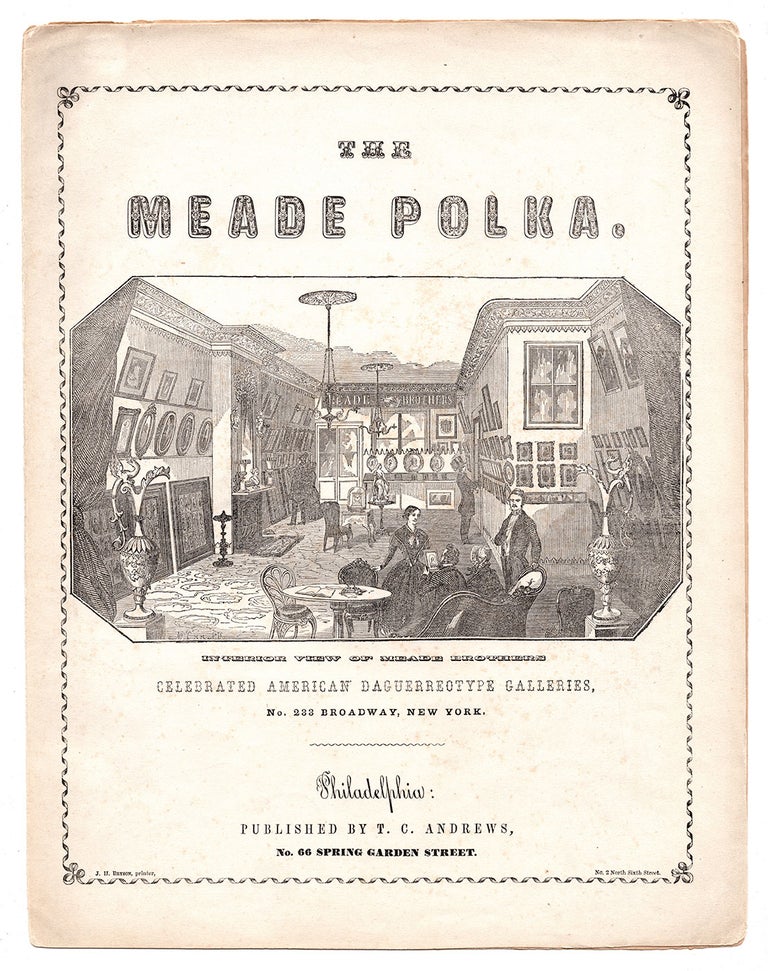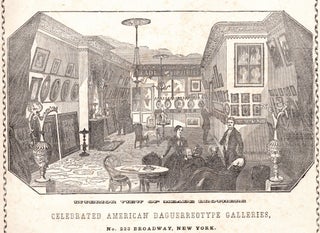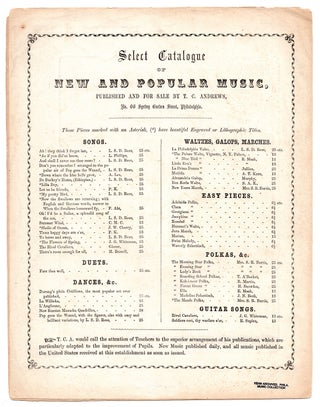The Meade Polka.
Philadelphia: T. C. Andrews, No. 66 Spring Garden St., [1854?]. J. H. Bryson, printer, No. 2 North Sixth Street. 4to (14” x 11”), self wrappers. Never bound. 6 pp., 1 wood engraving, 5.5” x 9.125”, publisher’s ‘Select Catalogue’ on p. 6. Ink ownership stamp of Kean Archives (a now dispersed private collection) at foot of p. 6. A scarce volume of sheet music illustrated with an engraved view of the interior of the daguerreotype gallery of the Meade Brothers of New York City, arguably the most extraordinary establishment of its kind at the time, which served as a showcase for important daguerreotypes. The engraving is an unusually detailed visual record of the interior of a daguerreotype gallery, a subject very infrequently pictured outside of the periodicals of the day. The view, looking from the rear of the gallery toward the entrance, reveals an elegant showplace, its walls hung with daguerreotypes in various sizes (some of them unusually large). On the left, frames containing multiple images lean up against the wall and large images in both oval and rectangular frames hang above them. Smaller daguerreotypes can be seen hanging on the opposite wall and others are displayed near the entrance. In the foreground, a couple sits on a couch regarding a daguerreotype. Standing before them is gallery manager Louisa Lackey, and to their right, the figure of a man, likely one of the Meade Brothers. In the background, a few other patrons view the images hanging on the walls.
The composer of the music, Mrs. S. R. Burtis, published at least two other works, Evening Star Polka (Lee & Walker, 1853) and The Lady's Book Polka (Andrews & Son, 1852). The present work, which is dedicated to the Meade Brothers, has the feel of a commissioned advertisement, which would be consistent with the marketing savvy of the Meades. Godey’s Lady’s Book reported receiving a copy in January 1855 and reproduced the score in the April 1855 issue. The engraving, executed by New York City wood-engraver Nathaniel Orr, also appeared as the frontispiece in the February 1853 issue of The Photographic Art Journal, which included a promotional article about the Meade Brothers, entitled Our Daguerrean Galleries.—No. 1. The Meade Gallery, New York, which provides a wonderful description of the collection and premises:
It is worthy of remark that this splendid daguerreotype establishment was built and adapted expressly for all branches of this most curious art; no expense it appears has been spared to introduce into it all the luxuries of modern times…We will give a slight sketch of some of the most prominent pictures in the collection which amounts now to over one thousand, some of them on plates 12 x 16.5 inches. First, Daguerre, the Father of the Art, taken in France in 1848, also a fine view of his chateau at Bri sur Marne, where he died last July. One of the Brothers leaves for Europe this month and will return with many valuable pictures of modern Europe and the Holy Land, also a view of the monument to Daguerre…The only pictures of Daguerre from life in America are in this establishment…The last pictures ever taken of those distinguished patriots, Clay and Wester are also here, the value of the latter may be imagined, when his son, Fletcher Webster Esq. had copies made from the picture for himself; while Ritchie is executing an engraving, Jones a medallion, and C. C. Wright a gold and 3,505 bronze medals from the prolific views of the illustrious Statesman’s face; next comes Louis Napoleon, Emperor of France, leader of the bon ton, now deceased. The eccentric Lola Montez, Countess of Landsfeldt in variety of costumes, Gen. Lopez, garroted at Havana, Louis Kossuth, the brilliant orator, “Kit Carson," Billy Bowlegs, the Seminole warrior and suite; a fine panoramic view of the City of San Francisco, California, the Falls of Niagara, Shakespear’s House, Stratford-on-Avon, the Boulevards, Place de la Concord, Arc de Triumph, Madalene, Notre Dame, &c., in Paris. Prof. Morse, the inventor of the telegraph; the sable Emperor and Empress of Hati; General Paez, Jenny Lind, Kate Hays, Commodore Perry of the Japan Expedition, Edwin Forrest, Views in North and South America, American Statesman, Actors, Poets and Divines, embracing nearly all persons, male and female, of celebrity, of modern times, many of whom are deceased…In this picture visitors will readily recognize Miss Louisa Lackey, the agreeable manageress of this department—her pleasing manners and knowledge of the business, makes it very pleasant for ladies and children sitting for their pictures. The Meade Brothers take every style of picture known in this beautiful art…They have one the largest apparatus in the world; their chemically colored daguerreotypes are much admired. They have two separate rooms for sitters with toilette rooms adjoining, and two large sky-lights with conveniences for taking groups of schools, colleges, military and fire companies…This popular establishment is now one of the lions of New York, and is well worth a visit from the resident or passing traveler.
Charles R. Meade (1826–1858) and Henry W. M. Meade (c. 1823–1865) made their first daguerreotypes in Albany in 1842 and soon branched out to Buffalo, Troy, and Saratoga Springs as well. From the beginning, they also sold daguerreian supplies and made miniature cases. The brothers soon earned the respect of their patrons and fellow photographers for the high quality of their work, which ultimately led to their rise to the summit of their profession. In 1846 they made daguerreotypes of Niagara Falls, which they sent to the King of France and the Emperor of Russia, receiving letters of acknowledgment and presents in return. Henry Meade traveled to Europe in 1847 and 1848, visiting Daguerre at his home and persuading him to sit for a daguerreotype. The brothers opened their New York gallery on Broadway in 1850, “probably the most ornate gallery of its kind in the world” (Rinhart), catering to the carriage trade. The firm suffered financial losses in the later 1850s and was taken over by Levi Chapman. Charles Mead died just short of his thirty-second birthday after a long illness said to have been caused by extensive exposure to photographic chemicals. Henry Mead committed suicide in 1865.
WorldCat records just three copies at LC, BYU, and Johns Hopkins.
A very appealing document of the daguerreotype business, rich in back story, and most suitable for display.
REFERENCES: The Photographic Art Journal, Vol. 5, No. 2, February 1853, pp. 99-100; Rinhart, Floyd and Marion. The American Daguerreotype (Athens, 1981), pp. 91-92.
CONDITION: Good, page 1 lightly foxed, pages 3-4 more heavily foxed.
Item #7079
Sold




